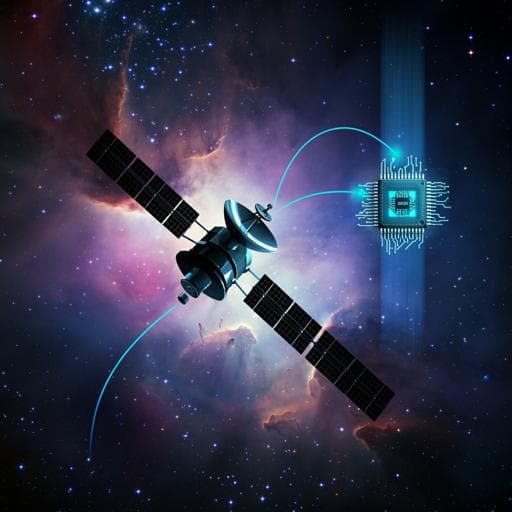
Engineering and Technology
Full daylight quantum-key-distribution at 1550 nm enabled by integrated silicon photonics
M. Avesani, L. Calderaro, et al.
Discover a groundbreaking prototype for daylight quantum key distribution (QKD) using integrated silicon-photonics technology, developed by a team of innovative researchers from the University of Padova and beyond. Achieving remarkable performance in real-world conditions, this research opens doors to cost-effective quantum optical applications, particularly in satellite missions.
~3 min • Beginner • English
Introduction
The study addresses how to realize robust free-space quantum key distribution (QKD) that works reliably in daylight while remaining compatible with telecom-band fiber systems and capable of stable single-mode fiber (SMF) coupling. Prior free-space demonstrations often operated at night or used 700–900 nm wavelengths with silicon SPADs, which struggle in daylight due to solar background. Operating at 1550 nm offers advantages: reduced solar background with good atmospheric transmission, compatibility with mature telecom components and integrated silicon photonics for compact, low-power, scalable transmitters suitable for portable and spaceborne systems. Achieving stable SMF coupling under atmospheric turbulence requires active correction (tip-tilt at minimum). The paper presents QCoSOne, a prototype implementing a 3-state 1-decoy QKD protocol at 1550 nm using an integrated silicon-photonics encoder in a rugged package, demonstrating continuous daylight QKD over an urban 145 m free-space link with very low QBER and practical key rates, moving toward hybrid satellite–fiber quantum networks at telecom wavelengths.
Literature Review
The introduction surveys the evolution of QKD protocols and implementations, highlighting the push toward global quantum networks combining fiber and free-space links. Most daylight free-space QKD used 700–900 nm to leverage low-noise silicon SPADs, but remain limited by solar background. Recent efforts at telecom C-band (around 1550 nm) began to explore reduced background and telecom compatibility. Integrated silicon photonics has emerged as a promising platform for compact, stable QKD transmitters, having demonstrated high-speed encoders and compatibility with telecom components. Stabilized SMF coupling in turbulence typically requires active tip-tilt correction; higher-order adaptive optics can further help but increases complexity. The authors also position their work against prior 1550 nm daylight demonstrations over long links (e.g., inter-satellite-path analogs and urban links) that faced varying turbulence levels and often reported asymptotic, not finite-key, rates, sometimes using multiple lasers with potential side-channel risks.
Methodology
System overview: The QCoSOne prototype establishes a free-space link between two buildings in Padua, Italy (145 m). Alice’s transmitter is a 12 cm achromatic refractor on a motorized tripod; Bob’s receiver is a 31.5 cm Cassegrain reflector (effective focal length 5000 mm) on a fixed mount. The free-space signal is coupled into an SMF at Bob via active pointing, acquisition, and tracking (PAT) correcting tip-tilt.
State preparation (Alice): A gain-switched DFB laser emits 50 MHz phase-randomized pulses (≈500 ps FWHM) at 1550 nm. Pulses are routed through a silicon photonic integrated circuit (PIC) (≈5×5 mm; packaged 1.2×1.5×1.2 cm; 20 DC and 6 RF ports) fabricated via IMEC’s silicon photonics platform. The PIC uses standard foundry blocks: multimode interferometers (50/50 splitters), thermo-optic modulators (TOMs, kHz bandwidth) and carrier-depletion phase modulators (CDMs, ~GHz).
- Intensity modulation: A Mach–Zehnder interferometer (MZI) with TOMs and CDMs produces decoy-state amplitudes μ1 and μ2 (μ1>μ2), selected by applying or not an RF drive to the CDMs.
- Polarization modulation: An inner MZI sets the colatitude; two external CDMs (CDM1, CDM2) set the relative phase, feeding a 2D grating coupler (GC2d) that converts path encoding to polarization encoding. With appropriate DC biases, |+> is the default output; RF π/2 phase shifts on either arm yield |L> or |R>. The encoder prepares three states for a 3-state protocol: Z-basis |0>=|L>, |1>=|R>; X-basis |+>. The measured extinction ratio per state is ~30 dB, implying an intrinsic optical QBER ≈0.1%.
Post-PIC optics: Pulses pass a 100 GHz DWDM filter (≈0.8 nm at 1550.94 nm), a VOA to set μ1, and a 99:1 splitter. The 1% port feeds a gated InGaAs/InP SPAD for real-time intensity monitoring; the 99% port combines with 1064 nm and 1545 nm beacons and is launched via the telescope.
Protocol parameters and control: Basis choice probabilities pz=0.9, px=0.1; decoy probabilities P(μ1)=0.7, P(μ2)=0.3; intensities set near optimal for 20–30 dB attenuation and ~1% QBER with nz≥1e8. Random bits are provided by a source-device-independent heterodyne-based QRNG. A Zynq SoC (FPGA locked to a 10 MHz GPS clock) generates laser triggers, RF drives for CDMs, and SPAD gating.
Receiver (Bob): The telescope couples the signal into a 40 m SMF to a state analyzer: a matched DWDM filter selects 1550 nm (post-filter coupling mean ≈6% due to filter insertion loss; ~12 dB), then a 90:10 splitter sets measurement probabilities (pz=0.9, px=0.1). Each arm includes an automatic polarization controller (APC) and a PBS; outputs go to four SNSPDs (ID281) at 0.8 K. Manual PCs before detectors optimize efficiency: ≈85% for Z detectors; ≈90% and ≈30% for |+> and |->, respectively; detection-efficiency mismatch is balanced by random discarding in post-processing. Dark counts ≈200 Hz per detector.
Timing and synchronization: SNSPD timestamps and Bob’s GPS PPS are recorded by a TDC (81 ps resolution). The transmitter FPGA is GPS-locked and uses PPS to schedule transmissions. A post-processing algorithm estimates and corrects the relative clock drift between GPS modules using detections between PPS ticks, yielding timing assignment with ≈400 ps RMS error.
PAT and coupling: Tip-tilt correction uses a fast-steering mirror (SmarAct) driven by the centroid from a PSD illuminated by Alice’s 1064 nm beacon. Closed-loop bandwidth ≈25 Hz. The receiver field-of-view is ≈5 μrad (half-angle at 50% coupling). Mean coupling into SMF just after the receiver telescope ≈8.5%; after the DWDM, mean coupling at 1550 nm ≈6% (12 dB). Performance characterization showed AoA RMS reduced from ≈15 μrad (off) to ≈0.2 μrad (on); coupling of a 1545 nm beacon (post-DWDM) improved from ≈2.9% to ≈9.5%. Fitting coupling histograms with a Kolmogorov-based model (with tip/tilt removed) yielded r0≈8.9 cm and maximum achievable coupling ≈34%.
Field procedure: On clear days in April 2019, after coarse telescope alignment using counter-propagating visible/near-IR beacons and camera imaging, fine alignment achieved stable SMF coupling via tip-tilt control. Bob’s measurement bases were aligned using APCs; extinction ratios >20 dB for all states. PIC settings were calibrated at the start of each day; only occasional re-alignment of receiver/transmitter SMFs (≈every 2 hours) was needed. QKD runs were performed to reach at least nz≥1e8 for finite-key processing. Post-processing used the AIT QKD R10 suite with Cascade error correction and finite-key privacy amplification for the 3-state 1-decoy protocol.
Key Findings
- Continuous daylight operation: Successful QKD from 11:00 to 20:00 CEST on April 18, 2019 (8 hours continuous).
- Detection and noise: Total detection rate within a 1 ns window averaged ≈100 kHz (range ≈60–130 kHz). Background within the window ≈200–400 Hz (≈240 Hz average). Signal-to-noise ratio ≈400.
- Losses and coupling: Total losses ≈22 dB on average (≈5 dB receiver optics, ≈5 dB state analyzer optics post-DWDM, ≈12 dB mean SMF coupling at 1550 nm). Mean coupling into SMF after the receiver telescope ≈8.5%; after DWDM ≈6%.
- Error rates: QBER <0.75% throughout, with best values QZ≈0.45% (Z basis) and QX≈0.25% (X basis). The integrated encoder’s intrinsic optical QBER ≈0.1% (≈30 dB ER per state).
- Secret key rates: Sifted rate ≈50–150 kbps depending on time of day. Finite-size SKR (SKRn) typically 20–70 kbps; maximum 65.8 kbps (April 17, late run). On April 18, each ≈50 min run yielded mean SKRn ≈33 kbps.
- PAT performance: Tip-tilt control reduced PSD centroid RMS from 120 μm (α≈15 μrad) to 1.5 μm (α≈0.2 μrad); 1545 nm coupling (post-DWDM) improved from ≈2.9% to ≈9.5%. Model fit indicated r0≈8.9 cm, CN^2≈1.1×10^-13 m^-2/3, and potential max coupling ≈34% (≈5 dB).
- Robustness and scalability: Asymptotic simulations indicate key generation tolerates ≈17 dB additional losses beyond measured, corresponding to ≈70 km if only diffraction is considered. Narrowing the detection window to 500 ps reduces rate by ≈12% but halves noise, potentially improving SKR at lower SNR.
- Comparative performance: For equal fixed losses, the implemented 3-state 1-decoy protocol outperforms prior 1550 nm daylight demonstrations up to ≈23 dB fixed attenuation; this work used a single laser source, mitigating multi-laser side-channel risks.
Discussion
The results demonstrate that integrated silicon photonics can reliably encode polarization and decoy intensities in a compact, rugged transmitter compatible with telecom-band components, enabling full daylight free-space QKD with stable SMF coupling. Achieving sub-1% QBER over extended daytime hours without active polarization stabilization underscores the encoder’s polarization stability, relevant for satellite platforms where long-term stability is crucial. The PAT system’s effective tip-tilt correction stabilized coupling under urban turbulence, with residual fluctuations small compared to the receiver’s coupling field-of-view. The measured SNR and low QBER enabled tens of kbps secret key rates with finite-key security. Simulations indicate significant headroom in tolerated losses, suggesting feasibility over substantially longer links when only diffraction is considered, and further improvements possible by optimizing time windows. Compared to other 1550 nm daylight trials, the combination of integrated encoding, single-laser source, finite-key analysis, and operation through high solar elevation highlights practical advances toward hybrid satellite–ground and ground–fiber quantum networks at telecom wavelengths.
Conclusion
This work presents a chip-based, telecom C-band free-space QKD prototype (QCoSOne) that achieves continuous daylight operation over an urban link with record-low QBER for free-space daylight QKD at 1550 nm and secret key rates of several tens of kbps. The integrated silicon-photonics encoder compactly implements both intensity and polarization modulation with excellent stability and low intrinsic errors, packaged for field deployment. Temporal, spectral, and spatial filtering combined with GPS-based timing and active tip-tilt correction overcame daylight background and turbulence to maintain stable SMF coupling. These results support the practicality of integrated photonics for portable and spaceborne quantum communication payloads and for seamless interfacing with fiber networks. Future work includes increasing clock rates (e.g., to ~1 GHz), adding adaptive optics to correct higher-order aberrations for improved coupling and longer link distances, and extending to device- and measurement-device-independent QKD scenarios within a broader satellite–fiber quantum internet.
Limitations
- Link length and environment: Results are from a short (145 m) urban link under clear, sunny conditions; performance over longer or more turbulent paths (e.g., strong urban daytime turbulence or adverse meteorology) was modeled but not experimentally verified here.
- Turbulence correction: Only tip-tilt was actively corrected; higher-order aberrations limited achievable coupling, as indicated by the gap to modeled maximum coupling.
- Optical insertion losses: The DWDM filter and analyzer optics contributed fixed losses, constraining overall efficiency.
- Detector imbalance: Measurement channels had differing detection efficiencies (e.g., |−> at ~30%), requiring post-processing balancing which can reduce usable counts.
- Synchronization jitter: GPS-based synchronization with ≈400 ps RMS timing error constrains the minimal detection window and background rejection.
- Finite-key regime: Reported SKRs include finite-key effects but depend on selected block sizes and parameter choices; different operating conditions may alter optimal settings and rates.
Related Publications
Explore these studies to deepen your understanding of the subject.







